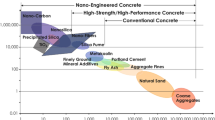Abstract
In the present work, carbon nano/microparticles obtained by controlled pyrolysis of peanut (PS) and hazelnut (HS) shells are presented. These materials were characterized by Raman spectroscopy and field emissionscanning electron microscopy (FE-SEM). When added to cement paste, up to 1 wt%, these materials led to an increase of the cement matrix flexural strength and of toughness. Moreover, with respect to plain cement, the total increase in electromagnetic radiation shielding effect when adding 0.5 wt% of PS or HS in cement composites is much higher in comparison to the ones reported in the literature for CNTs used in the same content.
Similar content being viewed by others
References
The Cement Sustainability Initiative. Recycling Concrete. The World Business Council for Sustainable Development (WBCSD). Accessed 22 March 2015, http://www.wbcsdcement.org/index.php/key-issues/sustainability-with-concrete/54
Brandt A M. Cement-based Composites, Materials, Mechanical Properties and Performance. 2nd ed. Routledge Editor, London and New York, 2009, 296
Li G Y, Wang P M, Zhao X. Mechanical behavior and microstructure of cement composites incorporating surface-treated multi-walled carbon nanotubes. Carbon, 2005, 43(6): 1239–1245
Konsta-Gdoutos M S, Metaxa Z S, Shah S P. Multi-scale mechanical and fracture characteristics and early-age strain capacity of high performance carbon nanotube/cement nanocomposites. Cement and Concrete Composites, 2010, 32(2): 110–115
Peters S J, Rushing T S, Landis E N, Cummins T. Nanocellulose and microcellulose fibers for concrete. Transportation Research Record, 2010, 2142: 25–28
Cao M, Zhang C, Wei J. Microscopic reinforcement for cement based composite materials. Construction & Building Materials, 2013, 40: 14–25
Ferro G, Ahmad S, Khushnood R A, Restuccia L. Improvements in self-consolidating cementitious composites by using micro carbonized aggregates. Frattura Integrità Strutturale, 2014, 30: 75–83
Ferro G, Tulliani J M, Lopez A, Jagdale P. New cementitious composite building material with enhanced toughness. Theoretical and Applied Fracture Mechanics, 2015, 76: 67–74
Ahmad S, Khushnood R A, Jagadale P, Tulliani J M, Ferro G. High performance self-consolidating cementitious composites by using micro carbonized bamboo particles. Materials & Design, 2015, 76: 223–229
Singh A P, Gupta B K, Mishra M, Govind, Chandra A, Mathur R B, Dhawan S K. Multiwalled carbon nanotube/cement composites with exceptional electromagnetic interference shielding properties. Carbon, 2013, 56: 86–96
Li B Y, Duan Y P, Zhang Y F, Lin S H. Electromagnetic wave absorption properties of cement-based composites filled with porous materials. Materials & Design, 2011, 32(5): 3017–3020
Bantsis G, Mavridou S, Sikalidis C, Betsiou M, Oikonomou N, Yioultsis T. Comparison of low cost shielding-absorbing cement paste building materials in X-band frequency range using a variety of wastes. Ceramics International, 2012, 38(5): 3683–3692
Dai Y, Sun M, Liu C, Li Z. Electromagnetic wave absorbing characteristics of carbon black cement-based composites. Cement and Concrete Composites, 2010, 32(7): 508–513
Pretorius J C, Maharaj B T. Improvement of electromagnetic wave (EMW) shielding through inclusion of electrolytic manganese dioxide in cement and tile-based composites with application for indoor wireless communication systems. 2013, 8: 295–301
Kong L, Yin X, Yuan X, Zhang Y, Liu X, Cheng L, Zhang L. Electromagnetic wave absorption properties of graphene modified with carbon nanotube/poly (dimethyl siloxane) composites. Carbon, 2014, 73: 185–193
Figarol A, Pourchez J, Boudard D, Forest V, Tulliani J M, Lecompte J P, Cottier M, Bernache-Assollant D, Grosseau P. Biological response to purification and acid functionalization of carbon nanotubes. Journal of Nanoparticle Research, 2014, 16(7): 2507
Konsta-Gdoutos M S, Metaxa Z S, Shah S P. Highly dispersed carbon nanotube reinforced cement based materials. Cement and Concrete Research, 2010, 40(7): 1052–1059
Son S Y, Lee Y, Won S, Lee D H, Kim S D, Sung S W. High- Quality Multiwalled Carbon Nanotubes from Catalytic Decomposition of Carboneous Materials in Gas-Solid Fluidized Beds. Industrial & Engineering Chemistry Research, 2008, 47(7): 2166–2175
Brandt A M. Cement-based Composites, Materials, Mechanical Properties and Per-formance, 2nd ed. Routledge Editor, London and New York, 2009, 21
Li V C, Maalej M. Toughening in cement based composites. Part I: Cement, mortar, and concrete. Cement and Concrete Composites, 1996, 18(4): 223–237
Brandt A M. Cement-based Composites, Materials, Mechanical Properties and Performance. 2nd ed. Routledge Editor, London and New York, 2009, 264–265
Merchant I J, Macphee D E, Chandler H W, Henderson R J. Toughening cement-based materials through the control of interfacial bonding. Cement and Concrete Research, 2001, 31(12): 1873–1880
Zampini D, Jennings H M, Shah S P. The interfacial Transition Zone and its Influence on the Fracture Behavior of Concrete, MRS Proc, 1994, 370: 357–366
Khushnood R A, Ahmad S, Savi P, Tulliani J M, Giorcelli M, Ferro G A. Improvement in electromagnetic interference shielding effectiveness of cement composites using carbonaceous nano/micro inerts. Construction & Building Materials, 2015, 85: 208–216
Nam I W, Kim H K, Lee H K. Influence of silica fume additions on electromagnetic interference shielding effectiveness of multi-walled carbon nanotube/cement composites. Construction & Building Materials, 2012, 30: 480–487
Author information
Authors and Affiliations
Corresponding author
Rights and permissions
About this article
Cite this article
Khushnood, R.A., Ahmad, S., Restuccia, L. et al. Carbonized nano/microparticles for enhanced mechanical properties and electromagnetic interference shielding of cementitious materials. Front. Struct. Civ. Eng. 10, 209–213 (2016). https://doi.org/10.1007/s11709-016-0330-5
Received:
Accepted:
Published:
Issue Date:
DOI: https://doi.org/10.1007/s11709-016-0330-5




